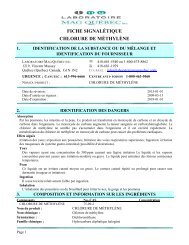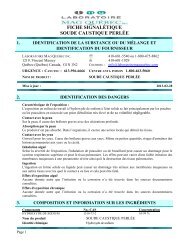sulfate de cuivre - Laboratoire Mag Québec inc.
sulfate de cuivre - Laboratoire Mag Québec inc.
sulfate de cuivre - Laboratoire Mag Québec inc.
Create successful ePaper yourself
Turn your PDF publications into a flip-book with our unique Google optimized e-Paper software.
Page 3<br />
La présente fiche signalétique est en vigueur pendant trois ans.<br />
FICHE SIGNALÉTIQUE Date <strong>de</strong> révision : 2011-12-15<br />
SULFATE DE CUIVRE Date d’entrée en vigueur : 2009-05-28<br />
Date d’expiration : 2014-12-15<br />
Protection <strong>de</strong> la peau : Porter <strong>de</strong>s vêtements résistant du produit. Tablier, combinaisons <strong>de</strong> travail, et/ou<br />
autres vêtements <strong>de</strong> protection résistants.<br />
Protection du visage<br />
et <strong>de</strong>s yeux : Lunettes <strong>de</strong> sécurité.<br />
Autre équipement<br />
<strong>de</strong> protection : Fournir <strong>de</strong>s douches <strong>de</strong> sécurité et oculaires à proximité <strong>de</strong>s lieux <strong>de</strong> travail.<br />
9. PROPRIÉTÉS PHYSIQUES ET CHIMIQUES<br />
État physique : Soli<strong>de</strong> Cristaux ou poudre<br />
Couleur : Bleue<br />
O<strong>de</strong>ur : Inodore.<br />
pH 4<br />
Densité relative : 2.286.<br />
Point d'ébullition : 150 °C / 302 °F.<br />
Point <strong>de</strong> congélation/fusion : Le <strong>sulfate</strong> <strong>cuivre</strong> pentahydrate perd <strong>de</strong>ux molécules d'eau à 30°C, encore 2<br />
à 110°C et <strong>de</strong>vient anhydre à 250°C. Fond à 110°C. Se décompose à<br />
560°C.<br />
Pression <strong>de</strong> vapeur : Non disponible.<br />
Densité <strong>de</strong> vapeur : Non disponible.<br />
% matière volatile (volume) : Non disponible.<br />
Taux d'évaporation : Non disponible.<br />
Solubilité : 17% par Wt @ 20°C.<br />
VOCs : Non disponible.<br />
Viscosité : Non disponible.<br />
Poids moléculaire : 249.68<br />
Autre : Non disponible.<br />
10. STABILITÉ ET RÉACTIVITÉ<br />
Stabilité : Stable.<br />
Polymérisation dangereuse : Ne se produira pas.<br />
Conditions a éviter : Aucun effet connu<br />
Incompatibilité (matières a éviter) : Le chauffage jusqu'à décomposition. Présence <strong>de</strong> matières<br />
<strong>inc</strong>ompatibles.<br />
Produits <strong>de</strong> décomposition dangereux : Oxy<strong>de</strong>s <strong>de</strong> soufre. Fumées toxiques.<br />
Information additionnelle : La solution peut réagir avec le magnésium et produire <strong>de</strong><br />
l'hydrogène. Le contact avec l'hydroxylamine enflammera<br />
l'hydroxylamine. Si dissous, il produit une solution aci<strong>de</strong> qui est<br />
corrosive pour la plupart <strong>de</strong>s métaux. La poussière ou le brouillard<br />
<strong>de</strong> <strong>cuivre</strong> peut réagir avec le gaz d'acétylène et produire <strong>de</strong>s<br />
acétylures <strong>de</strong> <strong>cuivre</strong> sensibles.<br />
11. INFORMATIONS TOXICOLOGIQUES<br />
Page 3<br />
Pr<strong>inc</strong>ipales voies d’entrée :<br />
Ingestion : Peut causer une douleur abdominale, une nausée et une gastrite.<br />
Peau : Le contact répété et/ou prolongé peut causer une irritation.<br />
Inhalation : Peut causer une ulcération du nez et <strong>de</strong> la gorge.





